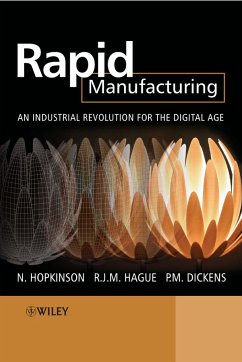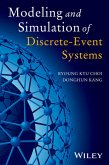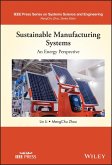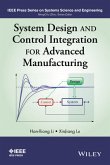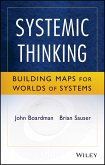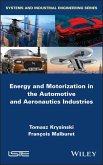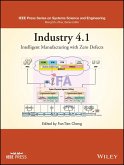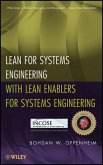Rapid Manufacturing (eBook, PDF)
An Industrial Revolution for the Digital Age
Redaktion: Hopkinson, Neil; Dickens, Philip; Hague, Richard
132,99 €
132,99 €
inkl. MwSt.
Sofort per Download lieferbar

0 °P sammeln
132,99 €
Als Download kaufen

132,99 €
inkl. MwSt.
Sofort per Download lieferbar

0 °P sammeln
Jetzt verschenken
Alle Infos zum eBook verschenken
132,99 €
inkl. MwSt.
Sofort per Download lieferbar
Alle Infos zum eBook verschenken

0 °P sammeln
Rapid Manufacturing (eBook, PDF)
An Industrial Revolution for the Digital Age
Redaktion: Hopkinson, Neil; Dickens, Philip; Hague, Richard
- Format: PDF
- Merkliste
- Auf die Merkliste
- Bewerten Bewerten
- Teilen
- Produkt teilen
- Produkterinnerung
- Produkterinnerung

Bitte loggen Sie sich zunächst in Ihr Kundenkonto ein oder registrieren Sie sich bei
bücher.de, um das eBook-Abo tolino select nutzen zu können.
Hier können Sie sich einloggen
Hier können Sie sich einloggen
Sie sind bereits eingeloggt. Klicken Sie auf 2. tolino select Abo, um fortzufahren.

Bitte loggen Sie sich zunächst in Ihr Kundenkonto ein oder registrieren Sie sich bei bücher.de, um das eBook-Abo tolino select nutzen zu können.
Rapid Manufacturing is a new area of manufacturing developed from a family of technologies known as Rapid Prototyping. These processes have already had the effect of both improving products and reducing their development time; this in turn resulted in the development of the technology of Rapid Tooling, which implemented Rapid Prototyping techniques to improve its own processes. Rapid Manufacturing has developed as the next stage, in which the need for tooling is eliminated. It has been shown that it is economically feasible to use existing commercial Rapid Prototyping systems to manufacture…mehr
- Geräte: PC
- ohne Kopierschutz
- eBook Hilfe
Andere Kunden interessierten sich auch für
![Modeling and Simulation of Discrete Event Systems (eBook, PDF) Modeling and Simulation of Discrete Event Systems (eBook, PDF)]() Byoung Kyu ChoiModeling and Simulation of Discrete Event Systems (eBook, PDF)107,99 €
Byoung Kyu ChoiModeling and Simulation of Discrete Event Systems (eBook, PDF)107,99 €![Sustainable Manufacturing Systems (eBook, PDF) Sustainable Manufacturing Systems (eBook, PDF)]() Lin LiSustainable Manufacturing Systems (eBook, PDF)111,99 €
Lin LiSustainable Manufacturing Systems (eBook, PDF)111,99 €![System Design and Control Integration for Advanced Manufacturing (eBook, PDF) System Design and Control Integration for Advanced Manufacturing (eBook, PDF)]() Han-Xiong LiSystem Design and Control Integration for Advanced Manufacturing (eBook, PDF)81,99 €
Han-Xiong LiSystem Design and Control Integration for Advanced Manufacturing (eBook, PDF)81,99 €![Systemic Thinking (eBook, PDF) Systemic Thinking (eBook, PDF)]() John BoardmanSystemic Thinking (eBook, PDF)27,99 €
John BoardmanSystemic Thinking (eBook, PDF)27,99 €![Energy and Motorization in the Automotive and Aeronautics Industries (eBook, PDF) Energy and Motorization in the Automotive and Aeronautics Industries (eBook, PDF)]() Tomasz KrysinskiEnergy and Motorization in the Automotive and Aeronautics Industries (eBook, PDF)139,99 €
Tomasz KrysinskiEnergy and Motorization in the Automotive and Aeronautics Industries (eBook, PDF)139,99 €![Industry 4.1 (eBook, PDF) Industry 4.1 (eBook, PDF)]() Industry 4.1 (eBook, PDF)121,99 €
Industry 4.1 (eBook, PDF)121,99 €![Lean for Systems Engineering with Lean Enablers for Systems Engineering (eBook, PDF) Lean for Systems Engineering with Lean Enablers for Systems Engineering (eBook, PDF)]() B. W. OppenheimLean for Systems Engineering with Lean Enablers for Systems Engineering (eBook, PDF)96,99 €
B. W. OppenheimLean for Systems Engineering with Lean Enablers for Systems Engineering (eBook, PDF)96,99 €-
-
-
Rapid Manufacturing is a new area of manufacturing developed from a family of technologies known as Rapid Prototyping. These processes have already had the effect of both improving products and reducing their development time; this in turn resulted in the development of the technology of Rapid Tooling, which implemented Rapid Prototyping techniques to improve its own processes. Rapid Manufacturing has developed as the next stage, in which the need for tooling is eliminated. It has been shown that it is economically feasible to use existing commercial Rapid Prototyping systems to manufacture series parts in quantities of up to 20,000 and customised parts in quantities of hundreds of thousands. This form of manufacturing can be incredibly cost-effective and the process is far more flexible than conventional manufacturing.
Rapid Manufacturing: An Industrial Revolution for the Digital Age addresses the academic fundamentals of Rapid Manufacturing as well as focussing on case studies and applications across a wide range of industry sectors. As a technology that allows manufacturers to create products without tools, it enables previously impossible geometries to be made. This book is abundant with images depicting the fantastic array of products that are now being commercially manufactured using these technologies.
Rapid Manufacturing: An Industrial Revolution for the Digital Age is a groundbreaking text that provides excellent coverage of this fast emerging industry. It will interest manufacturing industry practitioners in research and development, product design and materials science, as well as having a theoretical appeal to researchers and post-graduate students in manufacturing engineering, product design, CAD/CAM and CIFM.
Rapid Manufacturing: An Industrial Revolution for the Digital Age addresses the academic fundamentals of Rapid Manufacturing as well as focussing on case studies and applications across a wide range of industry sectors. As a technology that allows manufacturers to create products without tools, it enables previously impossible geometries to be made. This book is abundant with images depicting the fantastic array of products that are now being commercially manufactured using these technologies.
- Includes contributions from leading researchers working at the forefront of industry.
- Features detailed illustrations throughout.
Rapid Manufacturing: An Industrial Revolution for the Digital Age is a groundbreaking text that provides excellent coverage of this fast emerging industry. It will interest manufacturing industry practitioners in research and development, product design and materials science, as well as having a theoretical appeal to researchers and post-graduate students in manufacturing engineering, product design, CAD/CAM and CIFM.
Dieser Download kann aus rechtlichen Gründen nur mit Rechnungsadresse in D ausgeliefert werden.
Produktdetails
- Produktdetails
- Verlag: John Wiley & Sons
- Erscheinungstermin: 22. Februar 2006
- Englisch
- ISBN-13: 9780470032862
- Artikelnr.: 37289668
- Verlag: John Wiley & Sons
- Erscheinungstermin: 22. Februar 2006
- Englisch
- ISBN-13: 9780470032862
- Artikelnr.: 37289668
- Herstellerkennzeichnung Die Herstellerinformationen sind derzeit nicht verfügbar.
Neil Hopkinson is a lecturer in the Wolfson School of Mechanical and Manufacturing Engineering at Loughborough University, UK. Having obtained his PhD in Rapid Tooling in 1999, Neil began to look into the economic viability of Rapid Manufacturing. Inspired by the findings of this research Neil began to investigate lowcost, high-speed Rapid Manufacturing processes while also focusing his research on material properties in powder-based layer manufacturing processes. To date Neil has secured over £1 million of research funding and published over 40 journal/conference papers; he was also an invited visiting lecturer at the University of Queensland in Australia. Phill Dickens is Professor of Manufacturing Technology and Director of the Innovative Manufacturing and Construction Research Centre at Loughborough University, UK. He is also Associate Dean of Research for the Engineering Faculty. Phill started work in the area of Rapid Prototyping in 1990, working on processes such as 3D Welding and using copper coated SL models as electrodes for EDM. The research work has changed emphasis since then from Rapid Prototyping to Rapid Tooling and is now concentrating on Rapid Manufacturing. Richard Hague is a Senior Lecturer and Head of the Rapid Manufacturing Research Group at Loughborough University, UK. He has been involved with Rapid Prototyping and Rapid Manufacturing (RM) research since 1993, and is now Principal Investigator on several large EPSRC, DTI and EU funded research projects. He was also instrumental in setting up and managing the successful Rapid Manufacturing Consortium that now operates from Loughborough. Richard has many academic publications in the area of Rapid Manufacturing and is referee to several international academic journals and conferences. He also holds a patent that was gained as part of his PhD studies which is licensed to the predominant manufacturer of Rapid Prototyping equipment (3D Systems Inc.).
List of Contributors.
Editors.
Foreword (Terry Wohlers).
1 Introduction to Rapid Manufacturing (Neil Hopkinson, Richard Hague and
Phill Dickens).
1.1 Definition of Rapid Manufacturing.
1.2 Latitude of Applications.
1.3 Design Freedom.
1.4 Economic for Volumes down to One.
1.5 Overcoming the Legacy of Rapid Prototyping.
1.6 A Disruptive Technology.
1.7 A Breakdown of the Field of Rapid Manufacturing.
2 Unlocking the Design Potential of Rapid Manufacturing (Richard Hague).
2.1 Introduction.
2.2 Potential of Rapid Manufacturing on Design.
2.3 Geometrical Freedom.
2.4 Material Combinations.
2.5 Summary.
3 Customer Input and Customisation (R.I. Campbell).
3.1 Introduction.
3.2 Why Is Customer Input Needed?
3.3 What Input can the Customer Make?
3.4 How Can Customer Input Be Captured?
3.5 Using Customer Input within the Design Process.
3.6 What Is Customisation?
3.7 Determining Which Features to Customise.
3.8 Additional Customisation Issues.
3.9 Case Study - Customising Garden Fork Handles.
3.10 Conclusions.
4 CAD and Rapid Manufacturing (Rik Knoppers and Richard Hague).
4.1 Introduction.
4.2 CAD Background.
4.3 Relations between CAD and Rapid Manufacturing.
4.4 Future Developments Serving Rapid Manufacturing.
4.5 CAD for Functionally Graded Materials (FGMs).
4.6 Conclusion.
5 Emerging Rapid Manufacturing Processes (Neil Hopkinson and Phill
Dickens).
5.1 Introduction.
5.2 Liquid-Based Processes.
5.3 Powder-Based Processes.
5.4 Solid-Based Processes.
6 Materials Issues in Rapid Manufacturing (David L. Bourell).
6.1 Role of Materials in Rapid Manufacturing.
6.2 Viscous Flow.
6.3 Photopolymerization.
6.4 Sintering.
6.5 Infiltration.
6.6 Mechanical Properties of RM Parts.
6.7 Materials for RM Processes.
6.8 The Future of Materials in Rapid Manufacturing.
7 Functionally Graded Materials (Poonjolai Erasenthiran and Valter Beal).
7.1 Introduction.
7.2 Processing Technologies.
7.3 Rapid Manufacturing of FGM Parts - Laser Fusion.
7.4 Modelling and Software Issues.
7.5 Characterisation of Properties.
7.6 Deposition Systems.
7.7 Applications.
8 Materials and Process Control for Rapid Manufacture (Tim Gornet).
8.1 Introduction.
8.2 Stereolithography.
8.3 Selective Laser Sintering.
8.4 Fused Deposition Modeling.
8.5 Metal-Based Processes.
9 Production Economics of Rapid Manufacture (Neil Hopkinson).
9.1 Introduction.
9.2 Machine Costs.
9.3 Material Costs.
9.4 Labour Costs.
9.5 Comparing the Costs of Rapid Manufacture with Injection Moulding.
10 Management and Implementation of Rapid Manufacturing (Chris Tuck and
Richard Hague).
10.1 Introduction.
10.2 Costs of Manufacture.
10.3 Overhead Allocation.
10.4 Business Costs.
10.5 Stock and Work in Progress.
10.6 Location and Distribution.
10.7 Supply Chain Management.
10.8 Change.
10.9 Conclusions.
11 Medical Applications (Russ Harris and Monica Savalani).
11.1 Introduction.
11.2 Pre-Surgery RM.
11.3 Orthodontics.
11.4 Drug Delivery Devices.
11.5 Limb Prosthesis.
11.6 Specific Advances in Computer Aided Design (CAD).
11.7 In Vivo Devices.
12 Rapid Manufacturing in the Hearing Industry (Martin Masters, Therese
Velde and Fred McBagonluri).
12.1 The Hearing Industry.
12.2 Manual Manufacturing.
12.3 Digital Manufacturing.
12.4 Scanning.
12.5 Electronic Detailing.
12.6 Electronic Modeling.
12.7 Fabrication.
12.8 Equipment.
12.9 Selective Laser Sintering (SLS).
12.10 Stereolithography Apparatus (SLA).
12.11 Raster-Based Manufacturing.
12.12 Materials.
12.13 Conclusion.
13 Automotive Applications (Graham Tromans).
13.1 Introduction.
13.2 Formula 1.
13.3 Cooling Duct.
13.4 The 'Flickscab'.
13.5 NASCAR.
13.6 Formula Student.
14 Rapid Manufacture in the Aeronautical Industry (Brad Fox).
14.1 Opportunity.
14.2 Overview.
14.3 Historical Perspective.
14.4 Aeronautical Requirements for RM.
14.5 Why RM Is Uniquely Suited to the Aeronautical Field.
14.6 Acceptable Technologies.
14.7 Qualifying RM Systems.
14.7.1 Qualifying SLS at British Aerospace (BAe).
14.7.2 Qualifying SLS at Northrop Grumman.
14.8 Summary.
14.9 Case Studies.
15 Aeronautical Case Studies using Rapid Manufacture (John Wooten).
15.1 Introduction.
15.2 Problem and Proposed Solution.
15.3 Benefits of a Rapid Manufacture Solution.
15.4 Pre-Production Program.
15.5 Production.
15.6 Summary.
16 Space Applications (Roger Spielman).
16.1 Introduction.
16.2 Building the Team.
16.3 Quality Assurance.
16.4 How to 'Qualify' a Part Created Using This Process.
16.5 Producing Hardware.
17 Additive Manufacturing Technologies for the Construction Industry
(Rupert Soar).
17.1 Introduction.
17.2 The Emergence of Freeform Construction.
17.3 Freeform Construction Processes: A Matter of Scale.
17.4 Conclusions.
18 Rapid Manufacture for the Retail Industry (Janne Kyttanen).
18.1 Introduction.
18.2 Fascinating Technology with Little Consumer Knowledge.
18.3 The Need for Rapid Prototyping to Change to Rapid Manufacturing.
18.4 Rapid Manufacturing Retail Applications.
18.4.1 Lighting.
18.4.2 Three-Dimensional Textiles.
18.5 Mass Customisation.
18.5.1 Mass Customised Retail Products.
18.5.2 Future Posibilities of Mass Customised RM Products.
18.5.3 Limitations and Possibilities.
18.6 Experimentation and Future Applications.
Index.
Editors.
Foreword (Terry Wohlers).
1 Introduction to Rapid Manufacturing (Neil Hopkinson, Richard Hague and
Phill Dickens).
1.1 Definition of Rapid Manufacturing.
1.2 Latitude of Applications.
1.3 Design Freedom.
1.4 Economic for Volumes down to One.
1.5 Overcoming the Legacy of Rapid Prototyping.
1.6 A Disruptive Technology.
1.7 A Breakdown of the Field of Rapid Manufacturing.
2 Unlocking the Design Potential of Rapid Manufacturing (Richard Hague).
2.1 Introduction.
2.2 Potential of Rapid Manufacturing on Design.
2.3 Geometrical Freedom.
2.4 Material Combinations.
2.5 Summary.
3 Customer Input and Customisation (R.I. Campbell).
3.1 Introduction.
3.2 Why Is Customer Input Needed?
3.3 What Input can the Customer Make?
3.4 How Can Customer Input Be Captured?
3.5 Using Customer Input within the Design Process.
3.6 What Is Customisation?
3.7 Determining Which Features to Customise.
3.8 Additional Customisation Issues.
3.9 Case Study - Customising Garden Fork Handles.
3.10 Conclusions.
4 CAD and Rapid Manufacturing (Rik Knoppers and Richard Hague).
4.1 Introduction.
4.2 CAD Background.
4.3 Relations between CAD and Rapid Manufacturing.
4.4 Future Developments Serving Rapid Manufacturing.
4.5 CAD for Functionally Graded Materials (FGMs).
4.6 Conclusion.
5 Emerging Rapid Manufacturing Processes (Neil Hopkinson and Phill
Dickens).
5.1 Introduction.
5.2 Liquid-Based Processes.
5.3 Powder-Based Processes.
5.4 Solid-Based Processes.
6 Materials Issues in Rapid Manufacturing (David L. Bourell).
6.1 Role of Materials in Rapid Manufacturing.
6.2 Viscous Flow.
6.3 Photopolymerization.
6.4 Sintering.
6.5 Infiltration.
6.6 Mechanical Properties of RM Parts.
6.7 Materials for RM Processes.
6.8 The Future of Materials in Rapid Manufacturing.
7 Functionally Graded Materials (Poonjolai Erasenthiran and Valter Beal).
7.1 Introduction.
7.2 Processing Technologies.
7.3 Rapid Manufacturing of FGM Parts - Laser Fusion.
7.4 Modelling and Software Issues.
7.5 Characterisation of Properties.
7.6 Deposition Systems.
7.7 Applications.
8 Materials and Process Control for Rapid Manufacture (Tim Gornet).
8.1 Introduction.
8.2 Stereolithography.
8.3 Selective Laser Sintering.
8.4 Fused Deposition Modeling.
8.5 Metal-Based Processes.
9 Production Economics of Rapid Manufacture (Neil Hopkinson).
9.1 Introduction.
9.2 Machine Costs.
9.3 Material Costs.
9.4 Labour Costs.
9.5 Comparing the Costs of Rapid Manufacture with Injection Moulding.
10 Management and Implementation of Rapid Manufacturing (Chris Tuck and
Richard Hague).
10.1 Introduction.
10.2 Costs of Manufacture.
10.3 Overhead Allocation.
10.4 Business Costs.
10.5 Stock and Work in Progress.
10.6 Location and Distribution.
10.7 Supply Chain Management.
10.8 Change.
10.9 Conclusions.
11 Medical Applications (Russ Harris and Monica Savalani).
11.1 Introduction.
11.2 Pre-Surgery RM.
11.3 Orthodontics.
11.4 Drug Delivery Devices.
11.5 Limb Prosthesis.
11.6 Specific Advances in Computer Aided Design (CAD).
11.7 In Vivo Devices.
12 Rapid Manufacturing in the Hearing Industry (Martin Masters, Therese
Velde and Fred McBagonluri).
12.1 The Hearing Industry.
12.2 Manual Manufacturing.
12.3 Digital Manufacturing.
12.4 Scanning.
12.5 Electronic Detailing.
12.6 Electronic Modeling.
12.7 Fabrication.
12.8 Equipment.
12.9 Selective Laser Sintering (SLS).
12.10 Stereolithography Apparatus (SLA).
12.11 Raster-Based Manufacturing.
12.12 Materials.
12.13 Conclusion.
13 Automotive Applications (Graham Tromans).
13.1 Introduction.
13.2 Formula 1.
13.3 Cooling Duct.
13.4 The 'Flickscab'.
13.5 NASCAR.
13.6 Formula Student.
14 Rapid Manufacture in the Aeronautical Industry (Brad Fox).
14.1 Opportunity.
14.2 Overview.
14.3 Historical Perspective.
14.4 Aeronautical Requirements for RM.
14.5 Why RM Is Uniquely Suited to the Aeronautical Field.
14.6 Acceptable Technologies.
14.7 Qualifying RM Systems.
14.7.1 Qualifying SLS at British Aerospace (BAe).
14.7.2 Qualifying SLS at Northrop Grumman.
14.8 Summary.
14.9 Case Studies.
15 Aeronautical Case Studies using Rapid Manufacture (John Wooten).
15.1 Introduction.
15.2 Problem and Proposed Solution.
15.3 Benefits of a Rapid Manufacture Solution.
15.4 Pre-Production Program.
15.5 Production.
15.6 Summary.
16 Space Applications (Roger Spielman).
16.1 Introduction.
16.2 Building the Team.
16.3 Quality Assurance.
16.4 How to 'Qualify' a Part Created Using This Process.
16.5 Producing Hardware.
17 Additive Manufacturing Technologies for the Construction Industry
(Rupert Soar).
17.1 Introduction.
17.2 The Emergence of Freeform Construction.
17.3 Freeform Construction Processes: A Matter of Scale.
17.4 Conclusions.
18 Rapid Manufacture for the Retail Industry (Janne Kyttanen).
18.1 Introduction.
18.2 Fascinating Technology with Little Consumer Knowledge.
18.3 The Need for Rapid Prototyping to Change to Rapid Manufacturing.
18.4 Rapid Manufacturing Retail Applications.
18.4.1 Lighting.
18.4.2 Three-Dimensional Textiles.
18.5 Mass Customisation.
18.5.1 Mass Customised Retail Products.
18.5.2 Future Posibilities of Mass Customised RM Products.
18.5.3 Limitations and Possibilities.
18.6 Experimentation and Future Applications.
Index.
List of Contributors.
Editors.
Foreword (Terry Wohlers).
1 Introduction to Rapid Manufacturing (Neil Hopkinson, Richard Hague and
Phill Dickens).
1.1 Definition of Rapid Manufacturing.
1.2 Latitude of Applications.
1.3 Design Freedom.
1.4 Economic for Volumes down to One.
1.5 Overcoming the Legacy of Rapid Prototyping.
1.6 A Disruptive Technology.
1.7 A Breakdown of the Field of Rapid Manufacturing.
2 Unlocking the Design Potential of Rapid Manufacturing (Richard Hague).
2.1 Introduction.
2.2 Potential of Rapid Manufacturing on Design.
2.3 Geometrical Freedom.
2.4 Material Combinations.
2.5 Summary.
3 Customer Input and Customisation (R.I. Campbell).
3.1 Introduction.
3.2 Why Is Customer Input Needed?
3.3 What Input can the Customer Make?
3.4 How Can Customer Input Be Captured?
3.5 Using Customer Input within the Design Process.
3.6 What Is Customisation?
3.7 Determining Which Features to Customise.
3.8 Additional Customisation Issues.
3.9 Case Study - Customising Garden Fork Handles.
3.10 Conclusions.
4 CAD and Rapid Manufacturing (Rik Knoppers and Richard Hague).
4.1 Introduction.
4.2 CAD Background.
4.3 Relations between CAD and Rapid Manufacturing.
4.4 Future Developments Serving Rapid Manufacturing.
4.5 CAD for Functionally Graded Materials (FGMs).
4.6 Conclusion.
5 Emerging Rapid Manufacturing Processes (Neil Hopkinson and Phill
Dickens).
5.1 Introduction.
5.2 Liquid-Based Processes.
5.3 Powder-Based Processes.
5.4 Solid-Based Processes.
6 Materials Issues in Rapid Manufacturing (David L. Bourell).
6.1 Role of Materials in Rapid Manufacturing.
6.2 Viscous Flow.
6.3 Photopolymerization.
6.4 Sintering.
6.5 Infiltration.
6.6 Mechanical Properties of RM Parts.
6.7 Materials for RM Processes.
6.8 The Future of Materials in Rapid Manufacturing.
7 Functionally Graded Materials (Poonjolai Erasenthiran and Valter Beal).
7.1 Introduction.
7.2 Processing Technologies.
7.3 Rapid Manufacturing of FGM Parts - Laser Fusion.
7.4 Modelling and Software Issues.
7.5 Characterisation of Properties.
7.6 Deposition Systems.
7.7 Applications.
8 Materials and Process Control for Rapid Manufacture (Tim Gornet).
8.1 Introduction.
8.2 Stereolithography.
8.3 Selective Laser Sintering.
8.4 Fused Deposition Modeling.
8.5 Metal-Based Processes.
9 Production Economics of Rapid Manufacture (Neil Hopkinson).
9.1 Introduction.
9.2 Machine Costs.
9.3 Material Costs.
9.4 Labour Costs.
9.5 Comparing the Costs of Rapid Manufacture with Injection Moulding.
10 Management and Implementation of Rapid Manufacturing (Chris Tuck and
Richard Hague).
10.1 Introduction.
10.2 Costs of Manufacture.
10.3 Overhead Allocation.
10.4 Business Costs.
10.5 Stock and Work in Progress.
10.6 Location and Distribution.
10.7 Supply Chain Management.
10.8 Change.
10.9 Conclusions.
11 Medical Applications (Russ Harris and Monica Savalani).
11.1 Introduction.
11.2 Pre-Surgery RM.
11.3 Orthodontics.
11.4 Drug Delivery Devices.
11.5 Limb Prosthesis.
11.6 Specific Advances in Computer Aided Design (CAD).
11.7 In Vivo Devices.
12 Rapid Manufacturing in the Hearing Industry (Martin Masters, Therese
Velde and Fred McBagonluri).
12.1 The Hearing Industry.
12.2 Manual Manufacturing.
12.3 Digital Manufacturing.
12.4 Scanning.
12.5 Electronic Detailing.
12.6 Electronic Modeling.
12.7 Fabrication.
12.8 Equipment.
12.9 Selective Laser Sintering (SLS).
12.10 Stereolithography Apparatus (SLA).
12.11 Raster-Based Manufacturing.
12.12 Materials.
12.13 Conclusion.
13 Automotive Applications (Graham Tromans).
13.1 Introduction.
13.2 Formula 1.
13.3 Cooling Duct.
13.4 The 'Flickscab'.
13.5 NASCAR.
13.6 Formula Student.
14 Rapid Manufacture in the Aeronautical Industry (Brad Fox).
14.1 Opportunity.
14.2 Overview.
14.3 Historical Perspective.
14.4 Aeronautical Requirements for RM.
14.5 Why RM Is Uniquely Suited to the Aeronautical Field.
14.6 Acceptable Technologies.
14.7 Qualifying RM Systems.
14.7.1 Qualifying SLS at British Aerospace (BAe).
14.7.2 Qualifying SLS at Northrop Grumman.
14.8 Summary.
14.9 Case Studies.
15 Aeronautical Case Studies using Rapid Manufacture (John Wooten).
15.1 Introduction.
15.2 Problem and Proposed Solution.
15.3 Benefits of a Rapid Manufacture Solution.
15.4 Pre-Production Program.
15.5 Production.
15.6 Summary.
16 Space Applications (Roger Spielman).
16.1 Introduction.
16.2 Building the Team.
16.3 Quality Assurance.
16.4 How to 'Qualify' a Part Created Using This Process.
16.5 Producing Hardware.
17 Additive Manufacturing Technologies for the Construction Industry
(Rupert Soar).
17.1 Introduction.
17.2 The Emergence of Freeform Construction.
17.3 Freeform Construction Processes: A Matter of Scale.
17.4 Conclusions.
18 Rapid Manufacture for the Retail Industry (Janne Kyttanen).
18.1 Introduction.
18.2 Fascinating Technology with Little Consumer Knowledge.
18.3 The Need for Rapid Prototyping to Change to Rapid Manufacturing.
18.4 Rapid Manufacturing Retail Applications.
18.4.1 Lighting.
18.4.2 Three-Dimensional Textiles.
18.5 Mass Customisation.
18.5.1 Mass Customised Retail Products.
18.5.2 Future Posibilities of Mass Customised RM Products.
18.5.3 Limitations and Possibilities.
18.6 Experimentation and Future Applications.
Index.
Editors.
Foreword (Terry Wohlers).
1 Introduction to Rapid Manufacturing (Neil Hopkinson, Richard Hague and
Phill Dickens).
1.1 Definition of Rapid Manufacturing.
1.2 Latitude of Applications.
1.3 Design Freedom.
1.4 Economic for Volumes down to One.
1.5 Overcoming the Legacy of Rapid Prototyping.
1.6 A Disruptive Technology.
1.7 A Breakdown of the Field of Rapid Manufacturing.
2 Unlocking the Design Potential of Rapid Manufacturing (Richard Hague).
2.1 Introduction.
2.2 Potential of Rapid Manufacturing on Design.
2.3 Geometrical Freedom.
2.4 Material Combinations.
2.5 Summary.
3 Customer Input and Customisation (R.I. Campbell).
3.1 Introduction.
3.2 Why Is Customer Input Needed?
3.3 What Input can the Customer Make?
3.4 How Can Customer Input Be Captured?
3.5 Using Customer Input within the Design Process.
3.6 What Is Customisation?
3.7 Determining Which Features to Customise.
3.8 Additional Customisation Issues.
3.9 Case Study - Customising Garden Fork Handles.
3.10 Conclusions.
4 CAD and Rapid Manufacturing (Rik Knoppers and Richard Hague).
4.1 Introduction.
4.2 CAD Background.
4.3 Relations between CAD and Rapid Manufacturing.
4.4 Future Developments Serving Rapid Manufacturing.
4.5 CAD for Functionally Graded Materials (FGMs).
4.6 Conclusion.
5 Emerging Rapid Manufacturing Processes (Neil Hopkinson and Phill
Dickens).
5.1 Introduction.
5.2 Liquid-Based Processes.
5.3 Powder-Based Processes.
5.4 Solid-Based Processes.
6 Materials Issues in Rapid Manufacturing (David L. Bourell).
6.1 Role of Materials in Rapid Manufacturing.
6.2 Viscous Flow.
6.3 Photopolymerization.
6.4 Sintering.
6.5 Infiltration.
6.6 Mechanical Properties of RM Parts.
6.7 Materials for RM Processes.
6.8 The Future of Materials in Rapid Manufacturing.
7 Functionally Graded Materials (Poonjolai Erasenthiran and Valter Beal).
7.1 Introduction.
7.2 Processing Technologies.
7.3 Rapid Manufacturing of FGM Parts - Laser Fusion.
7.4 Modelling and Software Issues.
7.5 Characterisation of Properties.
7.6 Deposition Systems.
7.7 Applications.
8 Materials and Process Control for Rapid Manufacture (Tim Gornet).
8.1 Introduction.
8.2 Stereolithography.
8.3 Selective Laser Sintering.
8.4 Fused Deposition Modeling.
8.5 Metal-Based Processes.
9 Production Economics of Rapid Manufacture (Neil Hopkinson).
9.1 Introduction.
9.2 Machine Costs.
9.3 Material Costs.
9.4 Labour Costs.
9.5 Comparing the Costs of Rapid Manufacture with Injection Moulding.
10 Management and Implementation of Rapid Manufacturing (Chris Tuck and
Richard Hague).
10.1 Introduction.
10.2 Costs of Manufacture.
10.3 Overhead Allocation.
10.4 Business Costs.
10.5 Stock and Work in Progress.
10.6 Location and Distribution.
10.7 Supply Chain Management.
10.8 Change.
10.9 Conclusions.
11 Medical Applications (Russ Harris and Monica Savalani).
11.1 Introduction.
11.2 Pre-Surgery RM.
11.3 Orthodontics.
11.4 Drug Delivery Devices.
11.5 Limb Prosthesis.
11.6 Specific Advances in Computer Aided Design (CAD).
11.7 In Vivo Devices.
12 Rapid Manufacturing in the Hearing Industry (Martin Masters, Therese
Velde and Fred McBagonluri).
12.1 The Hearing Industry.
12.2 Manual Manufacturing.
12.3 Digital Manufacturing.
12.4 Scanning.
12.5 Electronic Detailing.
12.6 Electronic Modeling.
12.7 Fabrication.
12.8 Equipment.
12.9 Selective Laser Sintering (SLS).
12.10 Stereolithography Apparatus (SLA).
12.11 Raster-Based Manufacturing.
12.12 Materials.
12.13 Conclusion.
13 Automotive Applications (Graham Tromans).
13.1 Introduction.
13.2 Formula 1.
13.3 Cooling Duct.
13.4 The 'Flickscab'.
13.5 NASCAR.
13.6 Formula Student.
14 Rapid Manufacture in the Aeronautical Industry (Brad Fox).
14.1 Opportunity.
14.2 Overview.
14.3 Historical Perspective.
14.4 Aeronautical Requirements for RM.
14.5 Why RM Is Uniquely Suited to the Aeronautical Field.
14.6 Acceptable Technologies.
14.7 Qualifying RM Systems.
14.7.1 Qualifying SLS at British Aerospace (BAe).
14.7.2 Qualifying SLS at Northrop Grumman.
14.8 Summary.
14.9 Case Studies.
15 Aeronautical Case Studies using Rapid Manufacture (John Wooten).
15.1 Introduction.
15.2 Problem and Proposed Solution.
15.3 Benefits of a Rapid Manufacture Solution.
15.4 Pre-Production Program.
15.5 Production.
15.6 Summary.
16 Space Applications (Roger Spielman).
16.1 Introduction.
16.2 Building the Team.
16.3 Quality Assurance.
16.4 How to 'Qualify' a Part Created Using This Process.
16.5 Producing Hardware.
17 Additive Manufacturing Technologies for the Construction Industry
(Rupert Soar).
17.1 Introduction.
17.2 The Emergence of Freeform Construction.
17.3 Freeform Construction Processes: A Matter of Scale.
17.4 Conclusions.
18 Rapid Manufacture for the Retail Industry (Janne Kyttanen).
18.1 Introduction.
18.2 Fascinating Technology with Little Consumer Knowledge.
18.3 The Need for Rapid Prototyping to Change to Rapid Manufacturing.
18.4 Rapid Manufacturing Retail Applications.
18.4.1 Lighting.
18.4.2 Three-Dimensional Textiles.
18.5 Mass Customisation.
18.5.1 Mass Customised Retail Products.
18.5.2 Future Posibilities of Mass Customised RM Products.
18.5.3 Limitations and Possibilities.
18.6 Experimentation and Future Applications.
Index.
